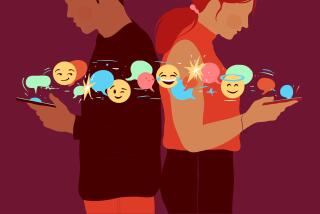Putting the app in therapy
- Share via
Your smartphone: It’s not just for texting, tweeting, waging war against little green pigs and — oh, right — calling people. It’s also for making yourself a happier, less stressed-out, more self-aware person.
Really, there’s an app for that. Any number of apps.
They come with names like Mood Swing and CBTReferee and BrainFreqz, and at their best, they offer users “‘treatment’ in the palm of their hand,” says Dr. John Luo, an associate clinical professor of psychiatry at UCLA. Many are free, many more cost 99 cents and none will set you back more than, say, a minute or two on a therapist’s couch would.
Apps may help, but couch those expectations
In short, it’s a “don’t worry — be app-y” world we live in now. Here’s a sampling of what you can find at Apple’s App Store, Microsoft’s Windows Phone Marketplace and other sites, or by using the Amazon Mobile App to comparison shop.
Mood-minder apps: These require that periodically, usually at least daily, you record your mood and whatever is going on in your life that may be affecting that mood. The app organizes the information and presents it in charts, graphs and calendars to give you a handle on when, where and with whom your moods slide up and down.
The Moody Me website suggests you’ll “Have more happy days!” if you use it. With this app, you can create a gallery with pictures of what makes you happy and play a slideshow “for an instant lift.”
The MoodPanda website maintains: “Over time, you can become more aware of your feelings, and the things that cause them. ... Just the simple act of showing people what has made them, and others, happier in the past is a sure fire way to make them happier in the future.”
Examples: Moody Me (Apple App Store, free), MoodPanda (Apple App Store, free), Mood Swing (Apple App Store, free, or Windows Phone Marketplace, ad-supported version free, ad-free version, 99 cents).
Therapy Apps: These also keep tabs on your moods but go a step further by providing the sorts of mood-improving strategies that patients often learn in therapy, most often via cognitive and behavioral strategies.
MoodKit, for instance, provides three other “tools” in addition to a mood tracker: five categories of mood-improvement activities (productivity, social, enjoyment, physical, healthy habits), a thought checker (to weed out negative thoughts) and a journal.
The iCouch CBT app (“CBT” stands for cognitive behavioral therapy) guides you through a step-by-step process of changing a negative, distorted thought to a better, not-distorted one. For a fee, you can send the whole shebang to iCouch and a licensed psychologist will evaluate how you’re using the app and make suggestions.
Live Happy provides eight activities intended to increase happiness, including savoring the moment, remembering happy days and keeping an acts-of-kindness journal. For savoring the moment, for instance, you take a picture of something special and write a short account of why you appreciate and value it.
Examples: MoodKit (Apple App Store, $4.99); iCouch CBT (Apple App Store, $1.99; psychologist evaluation, $7.99); Live Happy (Apple App Store, 99 cents).
Other approaches: Some mood apps seem pretty far off the wall. Consider BrainFreqz (don’t worry —”Freqz” refers to frequencies, not to any freaking out that app users might do). This app employs audio techniques intended to bring your brain wave frequencies into alignment with the frequencies of electromagnetic impulses traveling between the Earth’s surface and the ionosphere — a condition the BrainFreqz website calls “natural” and “very therapeutic.”
And should you ever have trouble deciding exactly what mood you’re in, there are apps for that too, such as Mood Scanner and Mood Finger Scan. These generally arrive at a verdict after scanning a convenient body part — finger or thumb — but their purveyors refrain from claiming that the verdict so rendered bears any relation to reality.
Examples: Mood Scanner (Android Market, free); Mood Finger Scan (Apple App Store, free).






